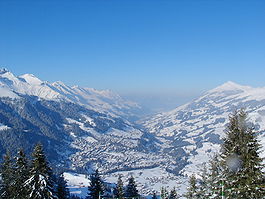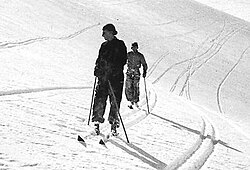Adelboden: Difference between revisions
→References: clean up and general fixes using AWB |
→Geography: update geography |
||
| Line 39: | Line 39: | ||
The most salient mountains are [[Lohner (mountain)|Lohner]] ({{m to ft|3049|abbr=yes}}), [[Steghorn]] ({{m to ft|3146|abbr=yes}}), [[Wildstrubel]] ({{m to ft|3243|abbr=yes}}), [[Fitzer]] ({{m to ft|2458|abbr=yes}}), [[Tschenten]] ({{m to ft|2025|abbr=yes}}) (mountain railway) and [[Gsür]] ({{m to ft|2708|abbr=yes}}). |
The most salient mountains are [[Lohner (mountain)|Lohner]] ({{m to ft|3049|abbr=yes}}), [[Steghorn]] ({{m to ft|3146|abbr=yes}}), [[Wildstrubel]] ({{m to ft|3243|abbr=yes}}), [[Fitzer]] ({{m to ft|2458|abbr=yes}}), [[Tschenten]] ({{m to ft|2025|abbr=yes}}) (mountain railway) and [[Gsür]] ({{m to ft|2708|abbr=yes}}). |
||
Adelboden has an area, {{as of|2009|lc=on}}, of {{km2 to mi2|88.19|abbr=on}}. Of this area, {{km2 to mi2|36.52|abbr=on}} or 41.4% is used for agricultural purposes, while{{km2 to mi2|16.07|abbr=on}} or 18.2% is forested. Of the rest of the land, {{km2 to mi2|2.18|abbr=on}} or 2.5% is settled (buildings or roads), {{km2 to mi2|1.53|abbr=on}} or 1.7% is either rivers or lakes and {{km2 to mi2|31.93|abbr=on}} or 36.2% is unproductive land.<ref name=BFS_land>[http://www.bfs.admin.ch/bfs/portal/de/index/themen/02/03/blank/data/gemeindedaten.html Swiss Federal Statistical Office-Land Use Statistics] 2009 data {{de icon}} accessed 25 March 2010</ref> |
|||
Of the built up area, industrial buildings made up 0.1% of the total area while housing and buildings made up 1.5% and transportation infrastructure made up 0.8%.. 14.4% of the total land area is heavily forested and 3.0% is covered with orchards or small clusters of trees. Of the agricultural land, 0.0% is used for growing crops and 8.5% is pastures and 32.9% is used for alpine pastures. All the water in the municipality is in rivers and streams. Of the unproductive areas, 9.6% is unproductive vegatation, 25.6% is too rocky for vegatation, and 1.1% of the land is covered by glaciers.<ref name=BFS_land/> |
|||
==History== |
==History== |
||
Revision as of 22:12, 2 April 2010
Adelboden | |
|---|---|
 | |
| Country | Switzerland |
| Canton | Bern |
| District | Frutigen-Niedersimmental |
| Area | |
| • Total | 88.2 km2 (34.1 sq mi) |
| Elevation | 1,350 m (4,430 ft) |
| Highest elevation | 3,242 m (10,636 ft) |
| Lowest elevation (Engstligen valley) | 1,045 m (3,428 ft) |
| Population (31 December 2018)[2] | |
| • Total | 3,390 |
| • Density | 38/km2 (100/sq mi) |
| Time zone | UTC+01:00 (Central European Time) |
| • Summer (DST) | UTC+02:00 (Central European Summer Time) |
| Postal code(s) | 3715 |
| SFOS number | 0561 |
| ISO 3166 code | CH-BE |
| Surrounded by | Diemtigen, Frutigen, Kandersteg, Lenk im Simmental, Leukerbad (VS), Sankt Stephan |
| Website | www SFSO statistics |
Adelboden is a municipality in the Frutigen-Niedersimmental administrative district in the Bernese Oberland in Switzerland.
Geography
Adelboden lies in the west of the Berner Oberland, at the end of the valley of the Engstlige river, which flows in Frutigen into the Kander river.
Adelboden is a traditional Swiss mountain village on a terrace looking south to the Engstligen waterfalls. Also part of the village are the inhabited valleys of Gilbach, Stigelschwand, Boden, Hirzboden, and Ausserschwand. Church and main street are at Template:M to ft, the highest point of the area is the Grossstrubel with Template:M to ft, the lowest point is at Template:M to ft in the Engstligen valley.

The vegetation is alpine and sub-alpine, partially wooded, the slopes, the plateaus, and terraces usually alp meadows.
The most salient mountains are Lohner (Template:M to ft), Steghorn (Template:M to ft), Wildstrubel (Template:M to ft), Fitzer (Template:M to ft), Tschenten (Template:M to ft) (mountain railway) and Gsür (Template:M to ft).
Adelboden has an area, as of 2009[update], of Template:Km2 to mi2. Of this area, Template:Km2 to mi2 or 41.4% is used for agricultural purposes, whileTemplate:Km2 to mi2 or 18.2% is forested. Of the rest of the land, Template:Km2 to mi2 or 2.5% is settled (buildings or roads), Template:Km2 to mi2 or 1.7% is either rivers or lakes and Template:Km2 to mi2 or 36.2% is unproductive land.[3]
Of the built up area, industrial buildings made up 0.1% of the total area while housing and buildings made up 1.5% and transportation infrastructure made up 0.8%.. 14.4% of the total land area is heavily forested and 3.0% is covered with orchards or small clusters of trees. Of the agricultural land, 0.0% is used for growing crops and 8.5% is pastures and 32.9% is used for alpine pastures. All the water in the municipality is in rivers and streams. Of the unproductive areas, 9.6% is unproductive vegatation, 25.6% is too rocky for vegatation, and 1.1% of the land is covered by glaciers.[3]
History
Adelboden is first mentioned in 1409 as in valle Adelboden. In 1453 it was mentioned as Adelboden alias silva.[4]
The alps Engstligenalp and Silleren belonging to Adelboden are mentioned for the first time in the 13th century. The inhabitants of Engstligental are called forest people. In the 15th century Adelboden got its own church and there were over 50 house fathers vouching for the salary of the minister.
In the 16th century Adelboden joined the Reformation, the Catholic minister fled over the Hahnenmoospass to the Catholic Canton of Fribourg.
Up to the 19th century, the only way to Frutigen was high on the south slope of the Engstligen valley and often impassable in winter. In the late 19th century a road along the Engstligen river was built joining Adelboden to the rest of the world.

In the 1870s the first boarding house was opened by one of the local teachers. It developed into a hotel, which is still in the possession of the same family (hotel Hari im Schlegeli). Around the turn of the century tourism led to a big increase in the population.
Adelboden was the destination of the first packaged winter sports holidays (vacations), organised by Sir Henry Lunn in 1903.
Into the 1930s the aerial ropeway to the Engstligenalp was built with further ropeways following. The Silleren area was up into the 1980s accessible by buses.
Rafael Sabatini died and is buried in Abelboden.
Main sights and cultural events

- Engstligen falls: the Engstligen river falls 600 m over rocks into the depth and forms one of the most impressive waterfalls in the Bernese Oberland. Very impressive is the "Alpaufzug" when 350 cows are driven upward on the narrow seam path through the cliff to the summer pasture on the Engstligenalp.
- Engstligenalp: plateau at 2000 m altitude
- The town's church, with early-20th centuries glassworks by Augusto Giacometti.
Cultural events include:
- FIS Alpine World Cup alpine ski races (January/February)
- Vogellisi-Festival (Live music, July)
- Kammermusic-festival (Chamber music, July)
Demographics
Adelboden has a population (as of 31 December 2020) of 3,343.[5] As of 2007[update], the population included 5.5% which were foreign nationals. Over the last 10 years the population has decreased at a rate of -1.2%.
In the 2007 election the most popular party was the SVP which received 38.3% of the vote. The next three most popular parties were the local small left-wing parties (28.8%), the CSP (13.4%) and the FDP (7.3%).
The age distribution of the population (as of 2000[update]) is: children and teenagers (0–19 years old) 26.4% of the population; adults (20–64 years old) 57.2%; and seniors (over 64 years old) 16.4%. The entire Swiss population is generally well educated. In Adelboden about 69.4% of the population (between age 25-64) have completed either non-mandatory upper secondary education or additional higher education (either University or a Fachhochschule).[6]
Historically the population was:[4]
| year | population |
|---|---|
| 1764 | 1,051 |
| 1850 | 1,513 |
| 1900 | 1,564 |
| 1910 | 2,163 |
| 1990 | 3,347 |
Languages
The language is Adelbodnertütsch, which belongs to the Bernese Oberland dialects with some loans from Valais dialects and belongs to the Highest Alemannic language group.
Most of the population (as of 2000[update]) speaks German (95.0%), with Serbo-Croat the second most common ( 1.0%), and Portugese third ( 0.9%).[4]
Government
Legislation is adopted by the biannual general assembly. Executive is the local council with nine members, all of whom are honorary.
Economics
Adelboden has a good mixture of agriculture, local industry (wood building companies, mineral water source) and tourism. People work in tourism, (approx. 490 persons), other services (approx. 500 persons), construction industry (approx. 310 persons), automobile industry (approx. 30 persons), mineral water source (approx. 45 persons) and agriculture (fulltime approx. 45 persons), taxidermy (fulltime approx. 16 persons)
Adelboden has an unemployment rate of 1.8%. As of 2005[update], there were 366 people employed in the primary economic sector and about 143 businesses involved in this sector. 601 people are employed in the secondary sector and there are 57 businesses in this sector. 1098 people are employed in the tertiary sector, with 153 businesses in this sector.[6]
Tourism and sport

Tourism in Adelboden is especially suitable for families. Adelboden has 24 hotels with 1291 beds, 3800 vacation homes with 15,200 beds, 28 group accommodations with 1830 beds, 3 camp sites and 40 restaurants.
In the summer there are 200 km (124 mi) of hiking trails, from sedate walks to alpine climbing-routes. Numerous mountain railways lead up to the mountains. Additional activities are: numerous mountain bike routes; and model aircraft construction on Hahnenmoospass with a workshop, and wind and landing opportunities.
In the winter there are ski runs of all degrees of difficulty, including the world-cup giant slalom run on the Kuonisbärgli, and cross-country ski trails. There are 40 km (25 mi) of winter hiking trails. For snowboarders there are freeride and freestyle runs.
The Adelboden slalom and giant slalom are considered classic events of the FIS Alpine World Cup.
Weather
| Climate data for Adelboden | |||||||||||||
|---|---|---|---|---|---|---|---|---|---|---|---|---|---|
| Month | Jan | Feb | Mar | Apr | May | Jun | Jul | Aug | Sep | Oct | Nov | Dec | Year |
| Source: MeteoSchweiz [7] | |||||||||||||
Traffic
Adelboden has only one incoming road connecting from Frutigen which connects via Spiez to the N6 and Bern. There is no transit traffic.
Frutigen is a train station of the Lötschberg line, connecting to Bern and Brig; it is connected to Adelboden by regular post bus services.
There is an old mountain pass route via Engstligenalp and Chindbettipass to the Gemmi Pass and into the Valais which is still used by hikers, and another connection via Hahnenmoospass into the valley of Lenk which was formerly used as a trade route to the lake of Geneva.
Schools
In Adelboden there is a primary school, middle-school and a secondary school; the nearest high school is in Frutigen.
Notable people
- The Swiss national ski mountain trainer Rolf Zurbrügg was born in Adelboden.
See also
External links
- Adelboden tourism Template:De icon
- Adelboden tourism Template:En icon
- Vogellisi-Festival Template:De icon
References
- ^ a b "Arealstatistik Standard - Gemeinden nach 4 Hauptbereichen". Federal Statistical Office. Retrieved 13 January 2019.
- ^ "Ständige Wohnbevölkerung nach Staatsangehörigkeitskategorie Geschlecht und Gemeinde; Provisorische Jahresergebnisse; 2018". Federal Statistical Office. 9 April 2019. Retrieved 11 April 2019.
- ^ a b Swiss Federal Statistical Office-Land Use Statistics 2009 data Template:De icon accessed 25 March 2010
- ^ a b c Adelboden in German, French and Italian in the online Historical Dictionary of Switzerland.
- ^ "Ständige und nichtständige Wohnbevölkerung nach institutionellen Gliederungen, Geburtsort und Staatsangehörigkeit". bfs.admin.ch (in German). Swiss Federal Statistical Office - STAT-TAB. 31 December 2020. Retrieved 21 September 2021.
- ^ a b Swiss Federal Statistical Office accessed 11-Jun-2009
- ^ "Average Values-Table, 1961-1990" (in German, French, and Italian). Federal Office of Meteorology and Climatology MeteoSwiss. Retrieved 8 May 2009.


